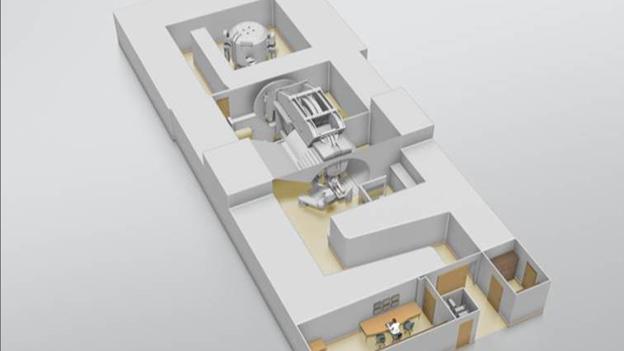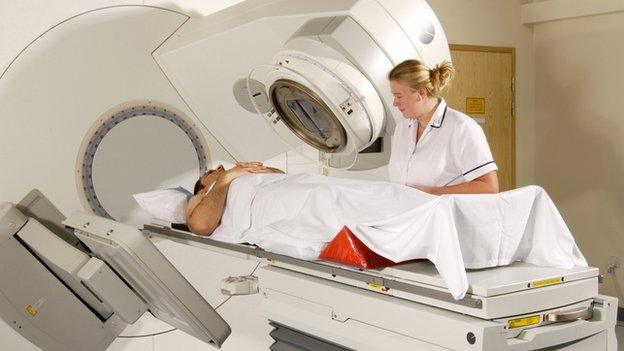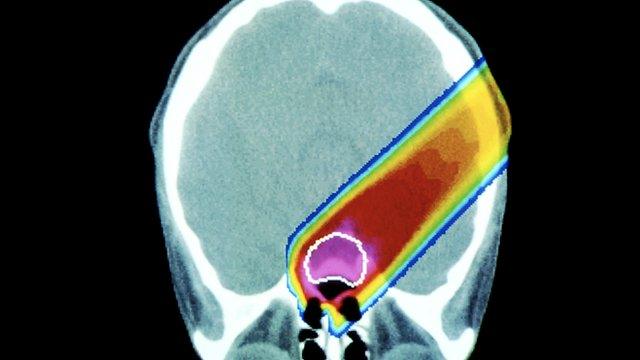Newport proton beam centre to treat 700 patients a year
- Published
Animated graphic comparing traditional radiation treatment with proton beam therapy.
The first cancer patients to get proton beam therapy at a UK centre will be treated in Newport by Christmas 2016.
Experts say it should "transform" treatment for 700 patients a year, including children with hard to reach tumours.
A former clinic will be converted and also offer traditional radiotherapy and chemotherapy.
Proton Partners International (PPI) set out its plans, saying it will cost the NHS less than sending patients abroad.
Protons can be directed at tumours more precisely than X-rays and they stop once they hit the target rather than carrying on through the body.
It makes operating on children's tumours - and cancers close to sensitive areas like the spinal cord - more exact.
Experts also say it reduces damage to healthy tissue and has fewer side-effects than radiotherapy.

A model of how the proton beam therapy centre could look, when the old building is refurbished
Oncology specialist Profr Karol Sikora said proton therapy could 'transform' care - especially for children.
They estimate the treatment will be suitable for about 10% of the 150,000 cancer patients who get radiotherapy in the UK every year.
Oncology specialist Professor Karol Sikora, chief medical adviser to PPI, said proton therapy could "transform treatment" for both NHS and those under private insurance schemes.
He said it might benefit 30% of prostate cancer patients, as well as those with lung cancer. A small number of paediatric patients could also be treated.
The treatment is only available in the UK for rare eye cancers on the Wirral.
The use of proton therapy was highlighted by the case of five-year-old Ashya King, whose parents took him to the Czech Republic for treatment for a brain tumour.
Around 140 patients a year are sent abroad by the NHS - mostly to the US and Switzerland - at a cost of around £114,000 each. That demand is expected to increase significantly and the developers envisage a network of 18 centres eventually.
The project was keen to stress the proposals were not a response to the Ashya case but had been planned for the last three years.
Prof Chris McGuigan, chair of the Life Sciences Hub Wales, external, said: "It will cost about half what the NHS pays at the moment but more importantly than that, for parents it will mean they won't have to shut up their homes while they fly abroad with their children for treatment."
'World map'
Centres will also be opened by the end of 2018 in Northumberland and close to Heathrow in west London, with hopes of two more to follow in Liverpool and Birmingham.
The centre on the Celtic Springs Business Park, in Newport, which is subject to planning permission, will employ about 20 hi-tech people - some recruited from abroad - but it will also become a training hub for the other centres.
The development is possible because the proton technology is getting smaller - and cheaper.
It can be operated with fewer staff, taking up far less space and at £20m, a quarter of the cost. Advanced imaging equipment will also be brought in and computers will help create the models which will help evaluate which patients can best benefit.
The developers estimate it could be worth £87m for the Welsh economy over its first three years.
Life sciences entrepreneur Prof Sir Chris Evans is backing the development and has secured £100m private investment. He said they were "fantastic proposals which will put Wales in the world map."
The NHS in England has invited the project leaders to a meeting next week and the NHS in Wales is said to be "very supportive".
Economy Minister Edwina Hart was at the launch in Cardiff.
- Published31 August 2014

- Published5 April 2015
